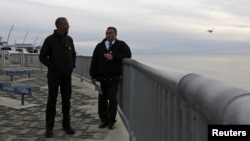Five Chinese Navy ships have been spotted in international waters off the coast of Alaska, according to U.S. officials, in what many analysts see as a fresh attempt by Beijing to project military power far from its shores.
Pentagon spokesman Bill Urban on Wednesday confirmed the presence of the five vessels, noting that it is the first time the U.S. has observed Chinese Navy ships in the Bering Sea.
"We respect the freedom of all nations to operate military vessels in international waters in accordance with international law," he said, adding that the U.S. military is tracking the ships.
White House spokesman Josh Earnest said U.S. officials have not detected any "threatening activities" by the ships, but said the intent of their presence was "still unclear."
The Chinese ship deployment came as President Barack Obama visited Alaska to build support for his environmental policies to combat climate change.
Coincidence?
But it is not likely Beijing planned the deployment to coincide with Obama's trip, said Ralph Cossa with the Center for Strategic and International Studies.
"I would guess that their presence during Obama's visit is coincidental more than deliberate. Because deployment like that is normally planned months in advance and I don't think anyone knew Obama was going to be in Alaska until a few days ago," Cossa told VOA.
However, the presence of the ships is meant to send a message to the U.S., he added.
"What it's saying is that at some point the Chinese are going to be just as obnoxious as we are when it comes to sailing around in international waters close to the other country's shores, and we should get used to it," he said.
The U.S. military has numerous bases in Asia and regularly conducts various air-and-ship-based activities off China's coasts in international waters.
"And China has repeatedly expressed its concerns about that," noted VOA Beijing correspondent William Ide. "It feels like China's trying to say if you're going to continue to do this, we're going to do the same."
U.S. officials say the Chinese flotilla is made up of three surface warfare ships, one amphibious assault ship, and a replenishment vessel.
If that is the case, the deployment represents less of a threat, and more of a projection of power, according to Scott Harold of the RAND Corporation.
"A replenishment vessel says to me this is in part a demonstration of its capacity to operate far from their shores," Harold told VOA.
"And an amphibious assault vessel would be absurd as a threat. No one is going to invade the United States by ground or by sea, much less are they going to do it in Alaska. But it is a symbol of China's ability to project naval or amphibious forces at some distance from China," he said.
Near-Arctic power
The deployment fits a larger pattern by China's navy, which is rapidly modernizing and attempting to venture out well beyond its shores.
And even though it does not border the resource-rich polar region, Beijing has made it clear that it wants to be regarded internationally as a "near-Arctic power," said Harold.
"Chinese leaders have clearly recognized that the resources that may be in the Arctic, the sea lines of communications that transit through the Arctic passageways that may open up as the ice melts are of tremendous potential value to China," he said.
Underscoring the strategic importance of the Arctic, Obama this week used his Alaskan tour to push lawmakers to speed up construction of a new heavy icebreaker ship that can navigate the region year-round.
The U.S. has just two functioning icebreakers, while Russia has 41. China unveiled its own icebreaker vessel in 2012, and plans to finish construction of another by 2016.










